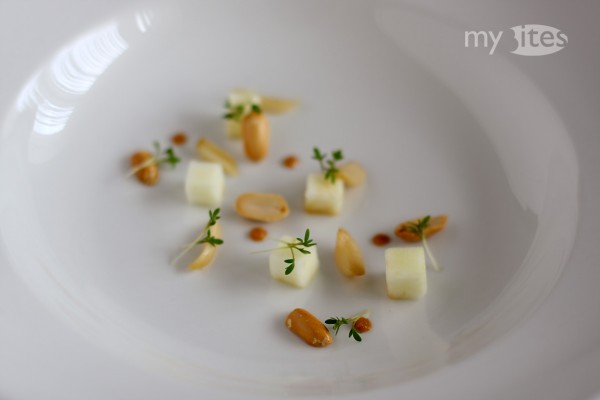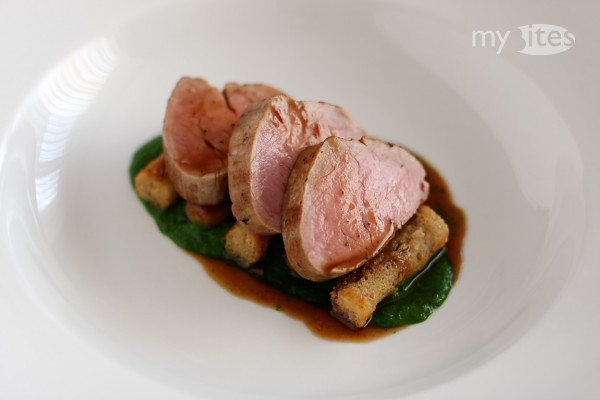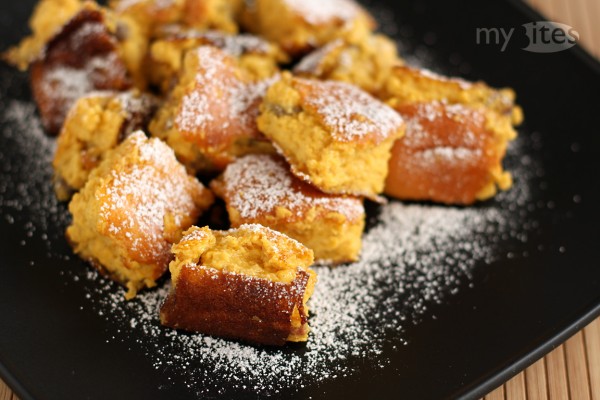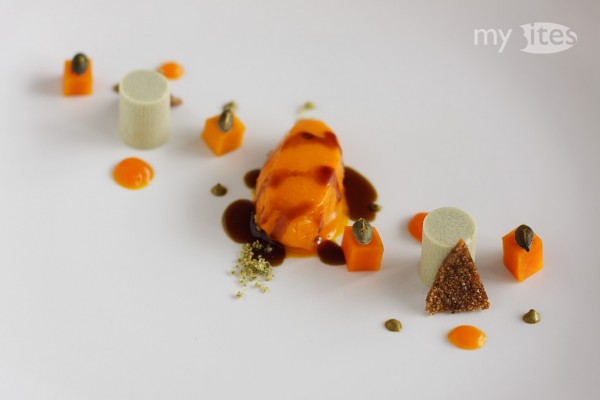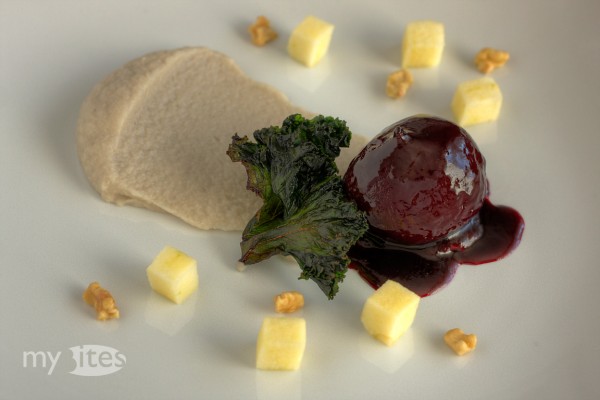When I cook rutabaga the evaporating scent always reminds me of peanuts. I’ve been planning to try the combination of rutabaga and peanut for a long time. Now it is rutabaga season, so I cooked a vegan soup using rutabaga and peanut butter.
Kale with Oat Dumplings, Shallots and Pork Tenderloin
In the northern part of Germany “Grünkohl mit Pinkel” is a traditional winter dish. It is basically a combination of kale (in German “Grünkohl”), oatmeal, onion and a smoked pork sausage made with oatmeal called “Pinkel”. You can find this dish at almost every winter festival like christmas markets, where it is prepared continuously in huge steaming pans. The main advantages of this dish are, that it is made completely from local produce, it is very simple to prepare, scales well and reheating is no problem either. It is also very stodgy and warms well on cold winter days. I thought that this traditional dish could be easily transformed into a more elaborate version by rethinking some of the main components and by restructuring the dish. Below you see my result.
Butternut Squash Kaiserschmarrn
Kaiserschmarrn is prepared the traditional way usually with apple puree and a vanilla-milk batter. With some imagination it can be turned into thousands of new variations. One possibility is the Caribbean coconut Kaiserschmarrn I posted a month ago, or another example would be this current butternut squash version – which is actually lactose-free. The squash adds both flavor and color to the final result, which is also the reason for its beautiful yellow appearance. I also experimented blending the softened squash with milk, but the result was much better when I used the reduced stock cooked from the seeds and skin of the butternut squash.
Science & Cooking
Between Christmas and New Year’s Eve there’s usually a gap of 1-2 days of free time. You can either get active and enjoy the snow, wrap yourself in warm blankets and watch movies or read a book. It’s also a great opportunity to finally get on with long postponed activities. If you love to cook, this suddenly available free time allows you to further train yourself either by trying new techniques in the kitchen, or by reading good cookbooks and watching lectures given by chefs.
Harvard had a very good course called Science and Cooking this autumn featuring many modern techniques and the most influential chefs of our time. The lectures are a mix of theoretical background information presented by scientists and a practical experience demonstrated by chefs. The theory is presented in the first 15-20 minutes of the lectures by David Weitz (physics professor at Harvard) and Harold McGee, who is well known for his revolutionary book On Food and Cooking. Afterwards the greatest chefs of our time such as Grant Achatz, Joan Roca and Ferran Adria demonstrate the physics discussed before by applying several modern cooking techniques.
Butternut Squash with Pumpkin Seeds
Thinking about vegan desserts it was surprising to me how much our usual desserts rely on animal products. Many – if not most – recipes contain either eggs, gelatin, butter, milk, cream or honey. Sometimes not even fruit sorbets are pure because adding some egg white or mascarpone makes their texture less crystalline. On the other hand, many animal products can be substituted: Instead of milk or cream you can create nutritious milk from rice or nuts. In many cases, butter can be substituted by flavorful vegetable oils. Honey too can be replaced by various natural sweeteners such as sugar beet molasses, agave or rice syrup. I believe that all these great plant-based products should not be treated as substitutions only, but rather as full-valued products. If we would stop thinking of them as substitutions and rather see them as full-valued ingredients, many new and creative desserts could be created.
Beets with Cashew-Salsify Puree, Apple, Walnut and Kale Chips
If you open a cookbook about classic french cooking you will find recipes for several sauces. Except for vinaigrettes, almost all sauces contain either milk, eggs or animal bones. So while I was exploring vegan cooking, my idea was to figure out whether it is possible to create a rich brown sauce by using vegetables only. My result was more than satisfactory. I didn’t taste the same as sauces prepared with animal parts, but this rich vegan brown sauce works great for coating or glazing baked or roasted vegetables.
